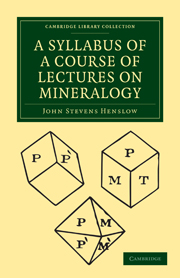A SYLLABUS OF LECTURES ON MINERALOGY
Published online by Cambridge University Press: 01 March 2011
Summary
Division of Natural History into three branches—subdivision into two—distinction between organized and unorganized bodies—Minerals, simple and compound.
Elementary bodies—compound substances. Definition of a simple Mineral—integrant molecule—component (or elementary) molecules.
Ex. gr. Sulphuret of Iron—carbonate of Lime. Definition of a compound Mineral—ex. gr. Granite.
Distinction between Mineralogy and Geology—mode of pursuing the study of Mineralogy—want of a precise arrangement—number of species inconsiderable.
Method of identifying species—characters of Minerals—terms used in Mineralogy—subdivision of Physical and Chemical characters.
ESSENTIAL CHARACTER
Composition of the integrant molecule—analysis of Minerals—estimation of the essential and accidental ingredients.
GEOMETRIC CHARACTERS
Crystallization—definition of a crystal—to every Mineral a certain series of crystals—ex. gr. Quartz—some forms common to different species.
Secondary crystals artificially constructed by the addition of integrant molecules to a primitive nucleus.
Laws of decrement:
1st. On the Edges—ex.gr. Rhomboidal and pentagonal dodecahedrons derived from the Cube.
2d. On the Angles—ex. gr. Regular octohedron derived from the Cube.
3d. Mixed decrements.
4th. Intermediate decrements.
Subtractive molecules.
Compound secondary crystals—ex. gr. Icosahedron.
Regular pentagonal dodecahedion and regular icosahedron incompatible with the laws of crystallization.
Number of crystalline forms—laws of decrement limited in nature.
Natural mode in which crystals are formed—from solution—from fusion.
Progress of crystallography—opinions of Linnæus—Tournefort—Romé de l'Isle—Bergman—Haüy.
All crystals of the same species reducible to one form—cleavage—ex. gr. Rhomboid extracted from all crystals of carbonate of lime—some primitive forms common to different species—Structure—Fracture.
- Type
- Chapter
- Information
- A Syllabus of a Course of Lectures on Mineralogy , pp. 1 - 6Publisher: Cambridge University PressPrint publication year: 2009First published in: 1823



